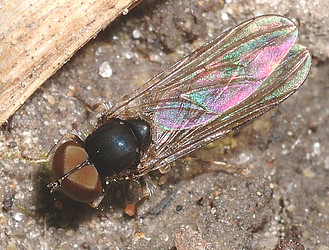Chalarinae
Jeff Skevington


This tree diagram shows the relationships between several groups of organisms.
The root of the current tree connects the organisms featured in this tree to their containing group and the rest of the Tree of Life. The basal branching point in the tree represents the ancestor of the other groups in the tree. This ancestor diversified over time into several descendent subgroups, which are represented as internal nodes and terminal taxa to the right.

You can click on the root to travel down the Tree of Life all the way to the root of all Life, and you can click on the names of descendent subgroups to travel up the Tree of Life all the way to individual species.
For more information on ToL tree formatting, please see Interpreting the Tree or Classification. To learn more about phylogenetic trees, please visit our Phylogenetic Biology pages.
close boxCharacteristics
These flies are immediately recognizable from other pipunculids by having the backs of their heads flattened (rounded in all other pipunculids). They also have strong bristles on their occiput and thorax. The genus Chalarus includes the smallest pipunculids, some only 4 mm long. Taxonomy of the group is very poorly studied. Revision of all genera in all regions is needed. Chalarus is particularly poorly known, with no described species in North America or Australia, despite considerable diversity in these regions.
Discussion of Phylogenetic Relationships
Both molecular and morphological evidence strongly support the hypothesis that this is the basal lineage of pipunculids (Rafael and De Meyer, 1992; Skevington and Yeates, 2000). Chalarus is the most plesiomorphic genus. The monophyly of Jassidophaga has often been questioned and Jassidophaga has been treated as part of Verrallia by some authors.
References
Rafael, J. A., and M. De Meyer. 1992. Generic classification of the family Pipunculidae (Diptera): a cladistic analysis. Journal of Natural History 26:637-658.
Skevington, J. H., and D. K. Yeates. 2000. Phylogeny of the Syrphoidea (Diptera) inferred from mtDNA sequences and morphology with particular reference to classification of the Pipunculidae (Diptera). Molecular Phylogenetics and Evolution 16:212-224.
Title Illustrations

| Scientific Name | Jassidophaga |
|---|---|
| Specimen Condition | Live Specimen |
| Identified By | Jeff Skevington |
| Sex | Male |
| Life Cycle Stage | adult |
| Copyright |
© Steve Marshall

|
About This Page
Jeff Skevington

Agriculture and Agri-Food Canada, Ottawa, Ontario, Canada
Correspondence regarding this page should be directed to Jeff Skevington at
skevingtonj@agr.gc.ca
Page copyright © 2005 Jeff Skevington
 Page: Tree of Life
Chalarinae.
Authored by
Jeff Skevington.
The TEXT of this page is licensed under the
Creative Commons Attribution License - Version 3.0. Note that images and other media
featured on this page are each governed by their own license, and they may or may not be available
for reuse. Click on an image or a media link to access the media data window, which provides the
relevant licensing information. For the general terms and conditions of ToL material reuse and
redistribution, please see the Tree of Life Copyright
Policies.
Page: Tree of Life
Chalarinae.
Authored by
Jeff Skevington.
The TEXT of this page is licensed under the
Creative Commons Attribution License - Version 3.0. Note that images and other media
featured on this page are each governed by their own license, and they may or may not be available
for reuse. Click on an image or a media link to access the media data window, which provides the
relevant licensing information. For the general terms and conditions of ToL material reuse and
redistribution, please see the Tree of Life Copyright
Policies.
- First online 02 November 2005
Citing this page:
Skevington, Jeff. 2005. Chalarinae. Version 02 November 2005 (under construction). http://tolweb.org/Chalarinae/54640/2005.11.02 in The Tree of Life Web Project, http://tolweb.org/







 Go to quick links
Go to quick search
Go to navigation for this section of the ToL site
Go to detailed links for the ToL site
Go to quick links
Go to quick search
Go to navigation for this section of the ToL site
Go to detailed links for the ToL site